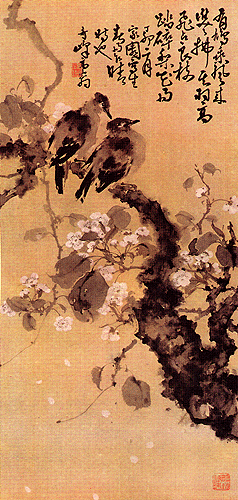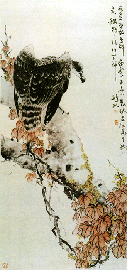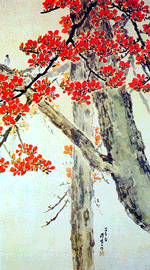|
|
LINGNAN
SCHOOL |
THE HISTORY
|
THE ROOTS
|
JAPANESE CONNECTION
|
LINGNAN MASTER
|
Introduction
Lingnan' or 'South of the Ranges' refers to that
part of China to the south of the 'Five Ranges' which are Tayu, Qitian,
Dupang, Mengzhu, Yuecheng. These ranges separate the river basin of
Changjiang, or the Yangzi River, in the central part of China fr'om that
of Zhujiang or the Pearl River, in the south. In the Tang dynasty
(618-906) Lingnan was the official name for the area covering the
provinces of Guangdong and Guangxi as well as Annan. The region covered by
the name Lingnan has changed with time. Today, 'Ling"'nan' aod 'Guangdong'
can almost be treated as synonyms.
Thus when we speak of 'Lingnan painting' today, we
are referring to the work of painters in the Guangdong province in
general. Strictly speaking, the two terms 'Lingnan painting' and 'Lingnan
School painting' are not interchangeable. The 'Lingnan School' is only one
of the many schools of painting in Lingnan, or Guangdong, and it should
not be used to refer to painting of the Guaiigdong province as a whole.
Since late nineteenth century, the Lingnan School of
painting has exerted tremendous influence on the painting development of
the Lingnan area, so much so that it brought forth a new movement in
Chinese painting in the first half of the twentieth century. This was the
result of the heroic effort of Gao jianfu (1879-195 1), Gao Qifeng
(1889.-1933) and Chen Shuren (1883-1948). The success of these three
painters was so prominent that they are hailed,as the 'Three Masters of
Lingnan'. To trace the early styles of the painting of the Lingnan School,
we shall have to study the work of the famous flower painters, ju Lian
(1828-1904), ju Chao (1811-1865), Song Guangbao (19th century) and
Mengjinyi (19th century.



it is interesting to note
how these masters were related to one another. Gao Qifeng learnt the art
of painting from his elder brother Gao jianfu. Two of the 'Three Masters
of Lingnan', Gao jianfu and Chen Shuren, were the students ofju Lian. Chen
Shuren was recorded to be the last student of ju Lian, and their
relationship was later further strengthened by the marriage of Chen with
the niece of his teacher. On the other hand, ju Lian was the younger
cousin ofju Chao. While ju Chao followed the painting style of Song
Guangbao, ju Lian studied the paintings of both Song
Guangbao and Meng jinyi and sought compromise between the opposite
styles of the two masters. If Gao jianfu, Gao Qifeng and Chen Shuren were
the major exponents of the Lingnan School, thenju Chao, ju Lian, Song
Guangbao and Mengjinyi were the forerunners.
Both Song and Meng were not natives of Guang- dong. Song Guangbao,
alias Outang, was a native of Changzhou district injiangsu province. He
was noted for his painting of flowers and plants in a near-to-realistic
manner in the style of Yuri Shouping (1633-1690), one of the Six Great
Masters of Early Qing. Meng jinyi, alias Litang, was a native of Yanghu
district, also in Jiangsu province. His bird-and-flower paintings were
modelled after those of Chen Shen (1483-1544) of the Ming dynasty
(1368-1644). Song and Meng were invited to Guangdong 4 painting teachers
by Li Bingshou, a native of jiangxi, was appointed to an official post in
Guangdong during the reign of Daoguang (1821-1850). These two masters soon
established themselves as the leading bird-and-flower painters in the
Lingnan district. Among those who followed their style of painting based
.on the study of plant forms were the ju cousins.
Ju Chao, alias Meisheng, pseudonym jinxianzhu, was
a native of the Panyu district in Guangdong province. He was a versatile
scholar noted for his painting, poetry and calligraphy. He was proficient
in the painting Of birds, flowers, inscects, fish, landscapes and human
figures. In the field of bird-and-flower painting, he was a master of the
'boneless technique'. His paintings on floral subjects have a touch of
refine- ment which reveals his full mastery of his brush-work and
colouring techniques, and his understanding of the system of growth of
flowers and plants.
ju Lian first learnt the art of painting from his cousin Ju Chao.
Later he learnt from the works of Song Guangbao and Meng jinyi and those
of earlier masters. He loved to paint flowers, plants and particularly
insects which he kept in his garden. His. love- for painting insects made
him the greatest insect painter in Guangdong. Although he took Song and
Meng and other masters as his models in painting, he was not bound by the
styles of anv of them. He succeeded in establishing a style of his own.
His special colouring technique in which water and powder colour were
skilfully applied to enrici tonal gradation and textural feeling of
leaves and flower petals, and his emphasis on the importance of detailed
study of objects in life laid down the basis on which the Lingnan Scho6i
painting later developed. Among the early masters of the Lingnan School,
ju Lian was by far the most influential of all.
The significance of the contribution of Lingnan School painters in the
development of Chinese painting in the 20th century cannot be over-
emphasized. To promote a better understanding of the work of this
important school of painting, the Hong Kong Museum of Art of the Urban
Council has engaged herself in a long term exhibition project beginning
with the presentation of the exhibition of 'Kwangtung Painting' in 197 3
when a general survey of the different schools of Guangdong paintings from
the Ming dynasty to mid-20th century was made. A similar exhibition called
by the name 'Lingnan Painting' based on the recent acquisitions of the
Hong Kong Museum of Art to supplement the 1973 survey was staged in 1976.
It was followed by a series of three one-man shows introducing the 'Three
Masters of Lingnan School', Gao jianfu, Chen Shuren and Gao Qifeng, in
1978, 1980 and 1982 respectively. To bring our survey of Lingnan School
masters up-to-date, two contemporary painters of that Scitool in Hong Kong
were introduced in out exhibition series under the title 'The Art of Chao
Shao-an' in 1979, and 'The Art of Yang Shen-sum' in 1981.
This is the tenth year since we first presented the 'Kwangtung
Painting' exhibition in our gallery, and we take delight to mark our
decade's effort in tracing the work of the Lingnan School by this
exhibition which, we hope, may bring to light the artistic achievements of
the forerunners of the school.
|









